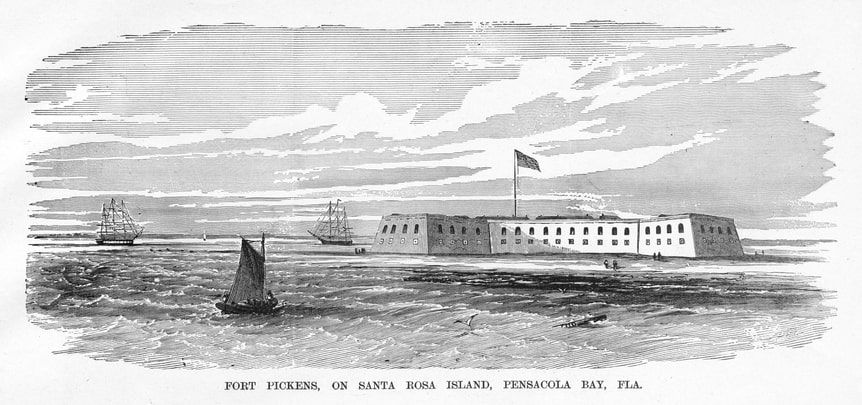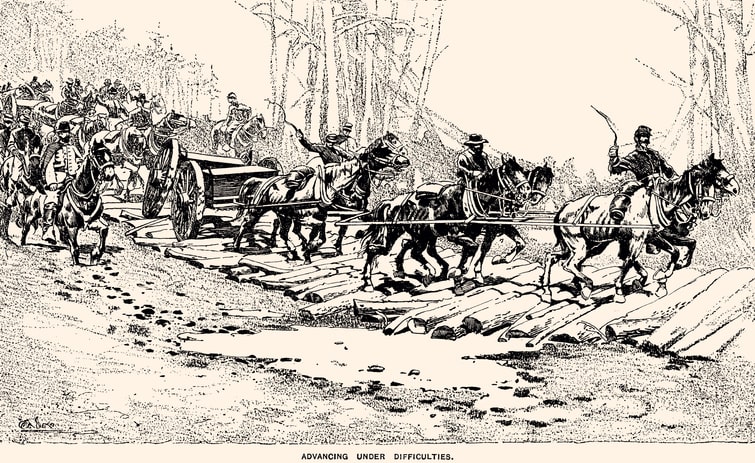The Confederate States of America


Following the election of Abraham Lincoln on an anti-slavery platform, 11 US states broke away from the union to form a republic that has become known as the Confederacy. The forming of a Confederate government essentially marked the beginning of the American Civil War.
Although this republic only lasted a total of 4 years, its impact still reverberates today. In this article, we shall examine the Confederacy states, the reasons for their secession (and readmittance), and the effects on both the states themselves and American history as a whole.
What Are the 11 Confederate States of America (CSA)?
The list of confederate states and the date of secession and readmittance to the union are as follows:
- South Carolina.
- Mississippi.
- Florida.
- Alabama.
- Georgia.
- Louisiana.
- Texas.
- Virginia.
- Arkansas.
- North Carolina.
- Tennessee.
What Is the Capital of the CSA?
The Confederate States of America had a total of three capitals over the course of its existence. The first Confederate capital was Montgomery, Alabama in 1847. Nicknamed the ‘Cradle of the Confederacy’, its capitol building hosted the convention that met to form the CSA itself.
Despite its position as a key location in the CSA, Montgomery also later became a focal point for the Civil Rights movement. The Reverend Dr. Martin Luther King Jr was a minister in the city from 1954-59 and led the bus boycott of 1955-56 after Rosa Parks refused to give up her seat on a racially-segregated bus. It elected its first black mayor in 2019.
Richmond, Virginia was the second capital of the CSA, from 1861 to 1865. Ironically, Richmond has had a number of black mayors; with the first, Henry Marsh, elected in 1977.
Finally, Danville, Virginia held the title of CSA capital for a total of eight days in April 1865, after Jefferson Davis and his cabinet fled there from Richmond. The Sutherlin Mansion, also known as the Last Capitol of the Confederacy, is a historical landmark.
Who Was the President of the Confederacy?
The first and only president of the Confederate States of America was Jefferson Davis. Davis was born in Kentucky in 1808 and raised in Mississippi; the youngest of ten siblings. After having served in the US Army, he was appointed Secretary of War by President Franklin Pierce. As a slaveholder, Davis was a firm believer in the institution of slavery.
An elected Senator, Davis, withdrew from the Senate after the secession of Mississippi in January 1861. A month later, the Confederate Congress in Montgomery, AL elected him President of the provisional government of the Confederacy, along with vice president Alexander H Stephens.
A year later, Davis was inaugurated for a six-year term albeit he was a reluctant President who preferred to be a military (rather than political) leader. Robert E. Lee was appointed General-In-Chief of the Confederate Army.
Although he was popular with the Southern people, he was unable to sustain this popularity over time, especially as the Confederate defeats mounted. He was captured by Northern soldiers near Irwinville, Georgia on May 10, 1865, and was imprisoned for two years in Virginia before being released in 1867.
He and his family traveled in Europe before returning and settling in Mississippi. Davis was keen to return to the US Senate but, having not been granted a pardon for his role in the Civil War, was unable to serve. He died in New Orleans in 1889. A year before his death, he urged the Southern people to “lay aside all rancor, all bitter sectional feeling, and to make your places in the ranks of those who will bring about a consummation devoutly to be wished—a reunited country.”
What Were the Confederate States Fighting For?

The confederate states were fighting to gain independence from the rest of the United States as they wished to uphold what they referred to as ‘Southern institutions’; the biggest of which was slavery.
Causes of Confederate Secession
All eleven confederate states declared slavery as one of the primary motivators for their secession. They believed that their livelihoods were tied up with the institution of slavery and could no longer be part of a country that might force them to abandon slavery.
The declarations of secession all contain similar messages. Of all the many rights they felt the federal government might strip away from them, slavery was the biggest.
Also, in a number of instances, the slave population was the majority or near-majority of the population. This was a concern in the slaveholding states and Northern opposition (as well as an increasing number of slave uprisings) led to the creation of a new government of the South.
The Confederate States of America: Order of Succession
The eleven states of the CSA seceded over a six-month period between December 1860 and June 1861. However, the period over which the states were readmitted took much longer; the first being readmitted in 1866 and the last in 1870.
We shall examine each state’s role in the secession from the Union below, in order of date seceded.
1. South Carolina

Seceded from the Union: 1860 Readmitted to the Union: 1868
South Carolina was the largest slave state by percentage of people in slavery and had the strictest laws toward freeing slaves. A key moment in the process of secession was the passing of the ordnance of nullification in 1832 which declared the federal government’s tariff laws null and void. Finally, on April 12, 1861, Confederate forces fired shots at Fort Sumter in Charleston and Union troops surrendered, sparking the Civil War.
By February 1865, Union forces were occupying South Carolina and thus began the long process of Reconstruction to reintegrate Southern states into the Union. However, this process was difficult and not without significant opposition. In 1867, an election was held in SC which was the first involving African Americans (albeit men only).
This led to a Confederate constitution being drawn up for the state in March 1868 and, in July of that year, President Andrew Johnson proclaimed that South Carolina had fulfilled the terms of readmittance to the Union.
2. Mississippi

Seceded from the Union: 1861 Readmitted to the Union: 1870
Mississippi was one of the largest slave states in the country prior to the Civil War with its economy based mainly on plantation agriculture. Mississippi (along with South Carolina) was one of the earliest advocates for secession and had called for this as early as 1850. Added to this was the fact that the president of the CSA, Jefferson Davis, was a Mississippi senator.
By 1860, the slave population in Mississippi was well over 430,000 compared with 350,000 White people in the state. However, despite its reliance on slave workers for its cotton production, slavery was as much a social issue as an economic one.
The election of Abraham Lincoln in 1860 acted as a catalyst for Mississippi secessionists who feared that the abolition of slavery was imminent. In January 1861, Mississippi became the second southern state to declare its intention to leave the Union.
Its place on the Mississippi River made it a key battleground in the Civil War and many battles were fought there.
Mississippi was finally readmitted to the Union in 1870. However, this did not ease the racial tensions within the state, and organizations such as the Ku Klux Klan were formed in the wake of readmittance. This led to race-related violence including the Vicksburg massacre of 1874.
3. Florida

Seceded from the Union: 1861 Readmitted to the Union: 1868
On January 10, 1861, the Florida secession convention voted 62 to 7 to secede from the Union. It was claimed that slaves in Florida were worth more than all the farmland in the South, and 44% of the population were property rather than citizens.
Many incidents had led to Florida’s secession, amongst them the North’s disregard for the 1850 Fugitive Slave Act and the John Brown uprising. But, as with other Confederate states, the election of Abraham Lincoln was the final catalyst.
Florida was a significant contributor to the war effort and saw two Confederate battles won on its soil. In addition, Tallahassee was the only capital east of the Mississippi River to avoid capture by Union troops during the civil war. However, support for the Confederacy among Floridians was by no means clear cut with many port cities inhabited by settlers from the North and rural areas by Southern settlers.
A month after the war ended in April 1865, Florida abolished slavery and its governor, John Milton, committed suicide. It was readmitted to the Union in June 1868.
4. Alabama

Seceded from the Union: 1861 Readmitted to the Union: 1868
The Alabama Constitution of 1861 was passed by its Secession Convention in January of that year. This was once again in response to the election of President Abraham Lincoln and was a rewrite of its original 1819 document. This allowed a framework for joining the CSA while protecting the institution of slavery.
Montgomery became the first capital of the CSA and Jefferson Davis was sworn in as President on the steps of its statehouse. Alabama militiamen began taking over federal forts in the state in anticipation of a conflict with the Union. Although its remote location ensured it was shielded from the worst fighting, north Alabama was mostly controlled by federal soldiers. In addition, as Alabama was a key supplier of weaponry to the Confederates, railroads in the state became strategic objectives and were taken by the Union at various points.
Although its Constitution had been rewritten in 1861, this version was never ratified by voters and was re-written in 1865 to allow for its readmittance to the Union. However, although Alabama eventually surrendered its arms, many never surrendered their beliefs, and tensions were to rise in the state on many occasions in the following years.
5. Georgia

Seceded from the Union: 1861 Readmitted to the Union: 1870
Georgia was the largest and most populous state of the Deep South and was crucial to the success of the CSA. Its Secession Convention voted unanimously to secede in January 1861 following Lincoln’s election. `
There were a number of key battles in Georgia during the Civil War, including The March to The Sea from Atlanta to Savannah in 1864, led by Union General William Sherman. The Tennessee Army had left the state of Georgia to Union soldiers and Sherman mounted this symbolic campaign to prove to the Confederate population that it had no power to resist invaders. On November 23 the state capital Milledgeville peacefully surrendered. The march was a huge blow to Confederate morale.
Georgia was initially readmitted to the Union in July 1868; however, there were mass protests denouncing Reconstruction policies with Black representatives removed from office and violence against Black people. In 1869, Georgia was barred from Congress with military rule reimposed. Georgia was admitted for a final time in 1870; however, soon after White segregationists took control of Georgia’s political landscape.
6. Louisiana

Seceded from the Union: 1861 Readmitted to the Union: 1868
Even before the decision to secede from the Union, Louisiana Governor Thomas O. Moore had ordered the seizure of a number of federal barracks in the state. The state voted overwhelmingly to secede in January 1861 and joined the CSA two months later.
The Forts Jackson and St Philip were relied upon by the Confederate Army to protect Louisiana from naval invasion. However, in April 1862, Union naval ships arrived New Orleans unopposed with Confederate troops either evacuating the city or surrendering shortly thereafter. This led to martial law under General Benjamin Butler whose hardline reign gave him the nickname of ‘The Beast’. Union troops later captured state capital Baton Rouge.
Later in the war, the campaign in Port Hudson, Louisiana, was one of the first times African American troops were involved. In total, more than 24,000 African American Louisianans would fight in the Civil War.
The Louisiana army was the last to surrender in May 1865 and, having fulfilled Congressional requirements, the state was readmitted into the union along with South Carolina, Georgia and Alabama in July 1868.
7. Texas

Seceded from the Union: 1861 Readmitted to the Union: 1870
Although only one in four Texas families owned slaves, there was strong support for secession following the election of Abraham Lincoln and the potential threat to the institution of slavery. Governor Samuel Houston was dedicated to the Union; however, the tide of opinion was against him and, when the state voted to secede, he refused to recognize the Confederacy and was removed from his position.
Despite the move to secession, a significant number of Texans supported the Union; in particular, the large number of German immigrants in Texas who formed groups to fight the 25,000-strong Texan Confederate Army. In addition, a large population of Mexican Texans were recruited by both the Union and Confederacy. Indeed, the border states with Mexico helped the Confederates move military supplies and other goods past the Union blockade in return for cotton.
The largest battles were fought away from Texas although the port of Galveston became a strategic location that was, at various points, controlled by both armies. Although the last battle of the war took place in Texas near Brownsville in May 1865 (with a Confederate victory), by this point Confederate soldiers were surrendering all across the South (many also fled to Mexico).
The most senior commanders in the Texan army surrendered in 1865. Despite ongoing objections, a new constitution was ratified in 1870 with Edmund J Davis voted in as Governor. President Ulysses S. Grant signed the act readmitting Texas to the Union in March 1870.
8. Virginia

Seceded from the Union: 1861 Readmitted to the Union: 1870
After the first shots of the Civil War were fired at Fort Sumter, the war moved to Virginia where Richmond was established as the CSA’s new capital. Many of the Confederate soldiers from Virginia were from rich households and those counties with the most slaves sent the most soldiers. They were fighting to protect their properties as well as the key industries and resources situated in the state.
Virginia was the first of the Upper South states to secede. However, not all Virginians supported the Confederacy. In 1863, the state of West Virginia was established by Unionists to the west of the state.
One of the most famous battles took place in Manassas in July 1861, after Union troops - under orders from President Lincoln – marched on Richmond. This battle led to Thomas J Jackson being nicknamed ‘Stonewall’ for his calm demeanor and stout defense.
Confederate forces in Virginia were eventually overrun by many deserting and the commanding officers either surrendered or were captured. By the end of the war in 1865, much of Virginia had been ravaged by war and was in severe debt.
Its new constitution was ratified by voters in 1869; however, many Confederates took on official duties as there were few people in the state who had the skills or experience who had not fought in the war.
9. Arkansas

Seceded from the Union: 1861 Readmitted to the Union: 1868
Prior to the Civil War, Arkansas had developed a successful cotton industry, albeit one very much rooted in slavery with one in five White citizens a slaveowner. However, despite this, the response to the election of Abraham Lincoln was initially mild and many were still loyal to the Union. But once the first shots were fired in the war, the state voted overwhelmingly for secession.
There was a proportion of the population opposed to the Confederates, in particular the mountainous regions of the north. However, elsewhere it was a different story, and it was believed that no other state had a larger proportion of military-age men in the Confederate Army than Arkansas.
Various areas of Arkansas fell to Federal forces during the war, and it lay defenseless for long periods of time. However, the introduction of martial law and the presence of guerilla forces meant brutal fighting took place in Arkansas. But the battles at Pea Ridge and Prairie Grove and, finally, Pine Bluff were crucial in establishing the state as a Union stronghold.
By the end of the war in 1865, the Confederacy in Arkansas had long since ceased to exist. Attempts to reconstruct Arkansas were complex and fraught. Slavery had been abolished and poor harvests meant its cotton industry suffered. The state returned to the Union in June 1868 but, as with many former Confederate states, Reconstruction was a long and complex process.
10. North Carolina

Seceded from the Union: 1861 Readmitted to the Union: 1868
North Carolina waited longer than any state (bar Tennessee) to secede from the Union. However, this was not due to the state being anti-slavery, but rather it did not want to give up the state’s rights and protections received in the Union. However, as with other states, the shots fired at Fort Sumter in April 1861 accelerated its secession.
Although c80% of White men in North Carolina signed up to fight, conscription was introduced, and a significant number fought out of fear of imprisonment or death if they refused. Indeed, many North Carolina Confederate soldiers supported the Union. Between 33,000-35,000 men died in battle or from disease during the war.
North Carolina saw relatively few military campaigns during the war due to its location away from major rivers. However, this did not prevent tensions between Unionists and Confederate forces. In 1863 in Madison County, members of the 64th North Carolina infantry killed 13 citizens suspected of being Unionists and deserters from the Confederate Army. A year later, Major General George E. Pickett hanged 22 North Carolinians who had fought for the Union after deserting the Confederacy.
Slavery had been abolished in North Carolina in 1863, long before the end of the war, and, by this time, many slaves had either fled north or joined the Federal army. The 13th Amendment was ratified in December 1865, leading to the end of slavery in North Carolina.
11. Tennessee

Seceded from the Union: 1861 Readmitted to the Union: 1866
In Tennessee, support for secession was by no means definitive. There were three divisions within the state; in the east, support for the Union was strong, in the Central Basin there was heavy support for secession and in the basin’s rim, there was ambivalence. This split led to divided families and neighborhoods.
In February 1861, a referendum voted against secession. The events at Fort Sumter forced many to reconsider their position; however, a second referendum in June of the same year only cemented opinion in the pro-Union east. Despite Tennessee deciding to join the Confederacy, the counties of East Tennessee drew up plans to form their own state. More than 31,000 Tennesseans joined Union forces; more than all the other Confederate states put together.
Confederate generals ordered forts to be built to protect Tennessee along the Mississippi, Tennessee, and Cumberland Rivers through to Kentucky. However, the battle of Mill Springs in January 1862 led to the Confederates retreating into Middle Tennessee. By February, several forts had fallen, and, on February 23, Federal forces entered Nashville, making Tennessee the first Confederate state capital to fall.
Several other battles took place over the coming years but, by the end of 1863, Tennessee was under Union control. The last meaningful battle, the battle of Nashville, took place in December 1864, and, by the spring of 1865, the war had ended in Tennessee.
On July 24, 1866, having been the last of the seceding states, Tennessee became the first state readmitted to the Union.
The Final Order of Secession and Readmittance
| State | Seceded from Union |
Readmitted to Union1 |
|
|---|---|---|---|
| 1. | South Carolina | Dec. 20, 1860 | July 9, 1868 |
| 2. | Mississippi | Jan. 9, 1861 | Feb. 23, 1870 |
| 3. | Florida | Jan. 10, 1861 | June 25, 1868 |
| 4. | Alabama | Jan. 11, 1861 | July 13, 1868 |
| 5. | Georgia | Jan. 19, 1861 | July 15, 18702 |
| 6. | Louisiana | Jan. 26, 1861 | July 9, 1868 |
| 7. | Texas | March 2, 1861 | March 30, 1870 |
| 8. | Virginia | April 17, 1861 | Jan. 26, 1870 |
| 9. | Arkansas | May 6, 1861 | June 22, 1868 |
| 10. | North Carolina | May 20, 1861 | July 4, 1868 |
| 11. | Tennessee | June 8, 1861 | July 24, 1866 |
NOTE: Four other slave states - Delaware, Maryland, Kentucky, and Missouri - remained in the Union. The latter two were actually represented on the Confederate flag, which, like the Stars and Stripes, featured a star for every state.
What Happened to the Confederate States?
The Emancipation Proclamation by President Lincoln in 1863 essentially signaled the beginning of the end of slavery. Following the end of the Civil War, America underwent the process of Reconstruction; involving the social and economic reintegration of the Confederate states back into the Union.
The Reconstruction Act of 1867 meant that Southern states had to ratify the 13th, 14th, and 15th Amendments, which included the abolition of slavery, the granting of equal rights to former slaves and the right to vote. By 1870, all states had been readmitted and Southern Black people were voted into both governments and Congress during this period.
However, many Southern states continued to both limit freedoms and exploit Black people through draconian and restrictive 'Black codes'. In addition, many White Southerners were unable to accept the changes brought about by Reconstruction and the likes of the Ku Klux Klan and other White supremacy organizations grew in both size and influence. By 1876, only Florida, Louisiana and South Carolina were still in the hands of the Federal (i.e. Republican) government.
The Compromise Act of 1876 marked the end of Reconstruction. The struggle to maintain civil rights in the South continued for a long time thereafter and, from the 1940s onwards, a new period of Civil Rights began; the struggle for which continues to this day.
| Territorial Expansion | U.S. History | The Declaration of Sentiments |
About the author







